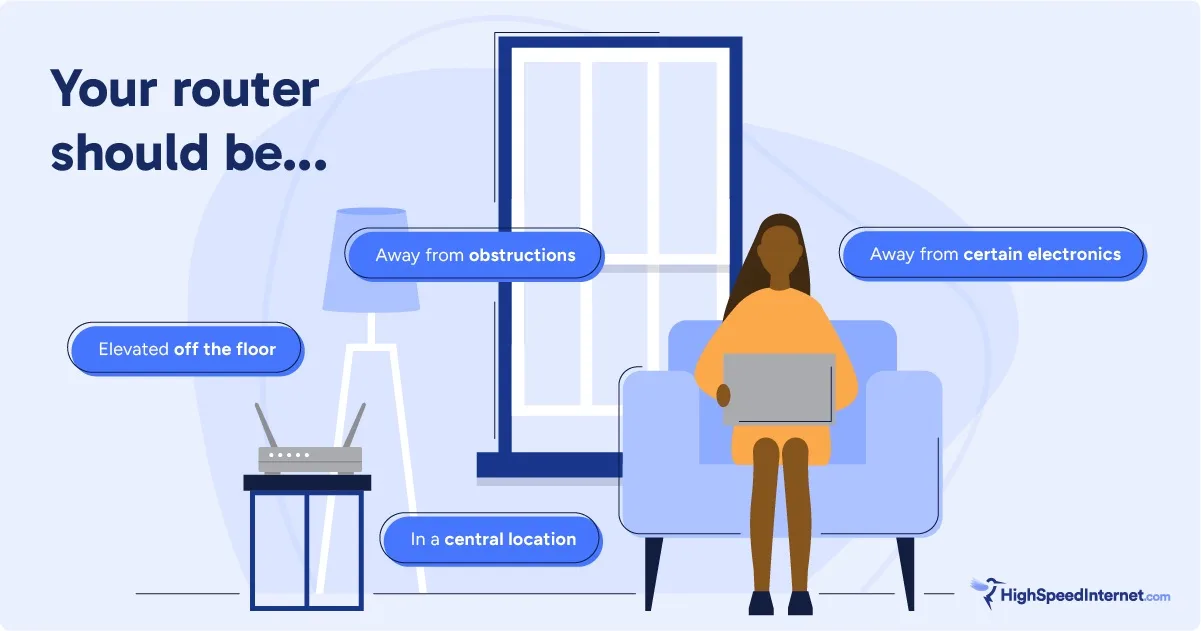Where Is the Best Place to Set Up Your Router?
Find out how to get the most Wi-Fi coverage out of your router
Jan 6, 2026 | Share
FAQ, Technology
Here’s the quick answer: Place your router in a central, unobstructed location.
Why? To ensure you have a strong Wi-Fi signal throughout your home. Moving your router even just a few feet might save you from endless hair-pulling connection woes and allow you to get the most out of your internet.
That said, use the tips in the table below when choosing a spot for your router. Of course, homes come in all shapes and sizes, and there are often other practical limitations on where you can put your router.

| Your router should be… | Why? |
|---|---|
| In a central location | Distribute Wi-Fi coverage to as much of your home as possible |
| Elevated off the floor | Increases Wi-Fi range |
| Away from obstructions | Prevents Wi-Fi signal blockage |
| Away from certain electronics | Prevents Wi-Fi signal interference |
If the table is enough for you, we’re glad we could help. Thank you and have a nice day. Keep reading if you want the full details and reasoning of these key router placement rules.
In this guide:
How do Wi-Fi signals work? | How to Maximize Signal | Tips for dealing with Dead Zones | FAQ
In this guide:
Choosing the best location for your router
When positioning your router in your home, the goal is to put it somewhere that takes advantage of the shape of your Wi-Fi signal and avoids interference from devices and obstructions. Here are some basic rules to help you do that.
Put your router in a central location
Wi-Fi broadcasts in all directions, but the signal strength weakens over distance. The best way to ensure that every room can get a good signal is to place the router in the most central location possible. Believe it or not, modern routers have enough amplified range to invade your neighbor’s home even if you placed it near the center of your home.
Minimize router obstructions
Wi-Fi signals can pass through objects like walls. But materials like metal, stone, water, and tile can severely weaken or even block Wi-Fi signals.
When choosing a spot for your router, think about what will be in between the router and the most important Wi-Fi zones in your home, like an office or living room.
Also, while Wi-Fi can pass through walls, doing so does weaken the signal somewhat–avoid walls where you can. An ideal situation would be to have a direct line of sight between your device and the router. For devices in other rooms, you’ll want to place the router in the spot where its signal has to pass through the lowest number of walls in order to reach the device.
Elevate your router
Never place computing devices on the ground, even your router. When sitting on the floor, they can overheat and be exposed to static shock, which can fry the components inside.
Routers are little computers dedicated to routing internet data, meaning they generate heat and get somewhat warm. They also broadcast Wi-Fi signals in an elongated donut shape, so you don’t want half of your Wi-Fi blasting into the floor. Routers should be at least 1–1.5 feet off the floor, preferably on a small table. You can also purchase a wall mount for your router as well.
One exception to this rule is people with multistory homes. Since you still want the router in the most central location, the best place for a router in a two-story home would be near the ceiling on the bottom floor or near the floor on the second floor. In either case, remember to consider the placement of your furniture so you don’t block your signal.
Avoid other electronics
Just as walls and large objects can interfere with your Wi-Fi signal, so can electronic devices. TVs and computers certainly fall into this category, but the biggest culprits are microwaves. The radiation put out by a microwave is pretty close to the wavelength of Wi-Fi signals, so it’s almost guaranteed to cause problems for your Wi-Fi if you set them up side by side. In other words, ban your router from lurking in the kitchen.
How do Wi-Fi signals work?
Modern routers have at least two omnidirectional antennas that put out a signal as a series of electromagnetic waves. Routers with external antennas adjusted vertically broadcast Wi-Fi horizontally in an elongated donut in every direction. You can adjust some of the antennas horizontally to accommodate rooms on the second floor, for example, but you reduce the long range.
Other routers have internal antennas you can’t adjust. These routers broadcast Wi-Fi in a sphere because of the way the antennas are positioned inside. These routers are ideal for homes that need more Wi-Fi on multiple floors versus in the backyard.
Adjusting your antennas
Some routers have adjustable, external antennas. Wi-Fi broadcasts perpendicular to the antenna’s position, so if you need Wi-Fi to reach every room on a single floor, keep them vertical. Likewise, your devices get the best reception if they’re on the same level as your router.
Technically, you could leave the antennas alone if you want Wi-Fi on other floors. Modern routers blast Wi-Fi, and may give you decent speeds upstairs or downstairs, depending on how your home is built. You can experiment with signal strength by angling a few antennas down a bit so they broadcast up and down.
But remember that if an object is blocking the signal between the router and your device, the signal can’t curve around it (although you will get a bit of signal bouncing off other surfaces).
Is your home Wi-Fi network slower than it should be?
If so, check out our 10 steps to improve your Wi-Fi speed.
Tips for dealing with Wi-Fi dead zones
Even if you’ve found the ideal spot where you’d like to set up your router, there are often practical considerations that prevent you from doing so. Your cable, fiber, or DSL outlet may be in an inconvenient spot, and some homes simply have unusually shaped floor plans. If this is the case, there are still a few more tips and tricks you can try to improve your Wi-Fi coverage.
Prioritize high-use areas
While a central location is the best way to reach every room of your house, some areas may take priority over others. For example, if your home office and living room are on the same side of the house, you might want to put your router closer to those rooms—even if it means a weaker signal in the kitchen.
While it’s ideal to have consistent home-wide Wi-Fi coverage, if your circumstances make a few dead spots unavoidable, it’s best if you get to choose where they are.
Use Ethernet cables
Depending on the layout of your home, you might end up with dead zones where you simply can’t get a good Wi-Fi signal. This might be in a room that was added to the house, one built next to a central bathroom and air handler closet, or one located near an abnormally thick wall.
An easy solution to this problem is to use Ethernet. Unlike a Wi-Fi signal that’s transmitted through the air and weakens over distance, you can bypass any obstacle with a long enough Ethernet cable.
If you’re lucky, Ethernet was pre-installed in your home. You’ll see Ethernet jacks on your walls and an Ethernet switch box near your modem or ONT. You can easily relocate your router and use wired devices anywhere in the house.
If your home isn’t pre-wired with Ethernet, you can still use long Ethernet cables to relocate your router and use wired devices anywhere in the house. We suggest flat cables and clips for mounting them along baseboards, keeping them out of sight. You could install Ethernet cables and ports in your walls, but you need to check with local building codes before drilling into joists and rafters.
Check out our guide on Ethernet vs. Wi-Fi to see which connection is best for you.
Get a specialized router
If your home is simply too big for your router to handle or has an overabundance of dead zones, you might want to upgrade. The modern routers we’ve tested generally have a decent long range, but our tests found some do a better job of eliminating dead zones than others.
Mesh systems were designed to overcome the shortfalls of standalone routers. They work best if you have two or more units in line of sight with each other, creating a strong web of connectivity. They help get Wi-Fi around objects that otherwise thwart your speeds when using a standalone router. They don’t have the long range, however, but they’re useful in pushing Wi-Fi upstairs or downstairs.
Here are some suggestions based on our tests:
- Best Long-Range Routers
- Best Wi-Fi 6E Routers
- Best Gaming Routers
- The Fastest Routers We’ve Tested
- Best Mesh Wi-Fi Systems and Routers
For more tips and tricks, check out our guide to getting wireless internet in every room of your home.
Use a Wi-Fi extender
Wi-Fi extenders create another access point in your Wi-Fi network by repeating the internet signal broadcast from your router. Extenders are a quick, easy, and affordable way to fill dead spots in your home.
Generally, Wi-Fi extenders work two ways. In repeater mode, the extender pulls data from the Wi-Fi signals it receives from your router and retransmits the data using a stronger signal—but your speed doesn’t increase. In access point mode, an extender is wired to your router using Ethernet. It acts like a secondary router, giving you better speeds than when the extender is set to repeater mode.
The downside is most extenders set to repeater mode double your connections latency, which may cause you to experience a delay in certain applications like online gaming, video calls, and any activity that relies on responsive internet connectivity. But if you just need to get a little more wireless bandwidth for streaming and browsing, extenders are a low-hassle solution.
Check out our guide on using a mesh router vs. a Wi-Fi extender to see which is best for you.
FAQ about placing your router
What room should I put my router in?
Should I put my router upstairs or downstairs?
How do I move my router to another room?
Author - Kevin Parrish
Kevin Parrish has more than a decade of experience working as a writer, editor, and product tester. He began writing about computer hardware and soon branched out to other devices and services such as networking equipment, phones and tablets, game consoles, and other internet-connected devices. His work has appeared in Tom’s Hardware, Tom's Guide, Maximum PC, Digital Trends, Android Authority, How-To Geek, Lifewire, and others. At HighSpeedInternet.com, he focuses on network equipment testing and review.
Editor - Jessica Brooksby
Jessica loves bringing her passion for the written word and her love of tech into one space at HighSpeedInternet.com. She works with the team’s writers to revise strong, user-focused content so every reader can find the tech that works for them. Jessica has a bachelor’s degree in English from Utah Valley University and seven years of creative and editorial experience. Outside of work, she spends her time gaming, reading, painting, and buying an excessive amount of Legend of Zelda merchandise.




